-
Countries
-
Data and Analysis
-
Special Focus
-
Crisis Responses
Return migration

Contact
DTM South Sudan, SouthSudanDTM@iom.int
Language
English
Location
South Sudan
Period Covered
Sep 01 2021
Oct 31 2021
Activity
- Survey
Between September and November 2021, the International Organization for Migration’s Displacement Tracking Matrix (IOM DTM) undertook its second household-level multi-sector assessment of selected urban areas and camps for internally displaced persons (IDPs) in South Sudan. The assessment aims to:
- Quantify the prevalence of vulnerabilities and humanitarian needs across sectors, with a focus on food security, economic vulnerability and nutrition as well as selected indicators on shelter and non-food items (SNFI), education, health, water, hygiene and sanitation (WASH), protection (including child protection and gender-based violence) and mental health and psycho-social support (MHPSS).
- Generate a better understanding of urban displacement and migration, including return and relocation after displacement in South Sudan or abroad.
This survey is part of the country-wide extended Food Security and Nutrition Monitoring System (FSNMS+) assessment in South Sudan, jointly conducted by IOM, the World Food Programme (WFP), the United Nations Children’s Fund (UNICEF), the Food and Agriculture Organization (FAO), the United Nations Office for the Coordination of Humanitarian Affairs (OCHA), REACH and several humanitarian clusters. It was designed to be an independent, crisis-wide and coordinated inter-agency multi-sectoral needs assessment, mandated by the Humanitarian Country Team and endorsed by the Inter-Cluster Coordination Group. Together, the joint findings provide an evidence-base for the Integrated Food Security Phase Classification, the Humanitarian Needs Overview and the Humanitarian Response Plan.
This report presents sectoral findings for Juba IDP Camp I and III. Separate profiles have been published for Juba’s urban area, Wau’s urban area and Naivasha IDP camp, the urban area of Bentiu / Rubkona and Bentiu IDP camp, Malakal’s urban area and Protection of Civilians (PoC) site and the urban areas of Bor and Yei.
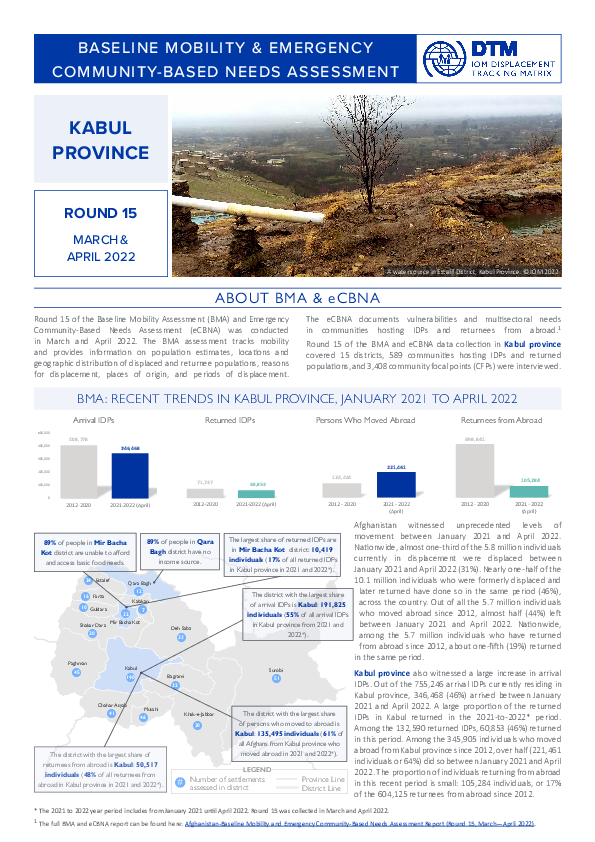
Contact
DTMAfghanistan@iom.int
Language
English
Location
Afghanistan
Period Covered
Mar 01 2022
Apr 30 2022
Activity
- Mobility Tracking
- Site Assessment
- Baseline Assessment
DTM has been conducting the Baseline Mobility Assessment in Afghanistan since 2016 to track mobility, provide information on population estimates, locations and geographic distribution of displaced and returnee populations, reasons for displacement, places of origin and periods of displacement. Vulnerabilities and multi-sectoral needs are covered in the Emergency Community- Based Needs Assessment (eCBNA) at the end of the report. Data is collected at the settlement level, through focus group discussions with community focal points and direct observations.
This province highlight delves into the key findings in Kabul province using the latest results from Round 15 of the BMA and eCBNA (conducted in March and April 2022), focusing on the 2021-to-2022 period. The full report can be found here: Baseline Mobility and Emergency Community-Based Needs Assessment Report (Round 15, March—April 2022)

Contact
DTMAfghanistan@iom.int
Language
English
Location
Afghanistan
Period Covered
Mar 01 2022
Apr 30 2022
Activity
- Mobility Tracking
- Baseline Assessment
DTM has been conducting the Baseline Mobility Assessment in Afghanistan since 2016 to track mobility, provide information on population estimates, locations and geographic distribution of displaced and returnee populations, reasons for displacement, places of origin and periods of displacement. Vulnerabilities and multi-sectoral needs are covered in the Emergency Community- Based Needs Assessment (eCBNA) at the end of the report. Data is collected at the settlement level, through focus group discussions with community focal points and direct observations.
The key findings report summarizes the results of Round 15 of the BMA and eCBNA (conducted in March and April 2022), focusing on the 2021-to-2022 period. The full report can be found here: Baseline Mobility and Emergency Community-Based Needs Assessment Report (Round 15, March—April 2022)
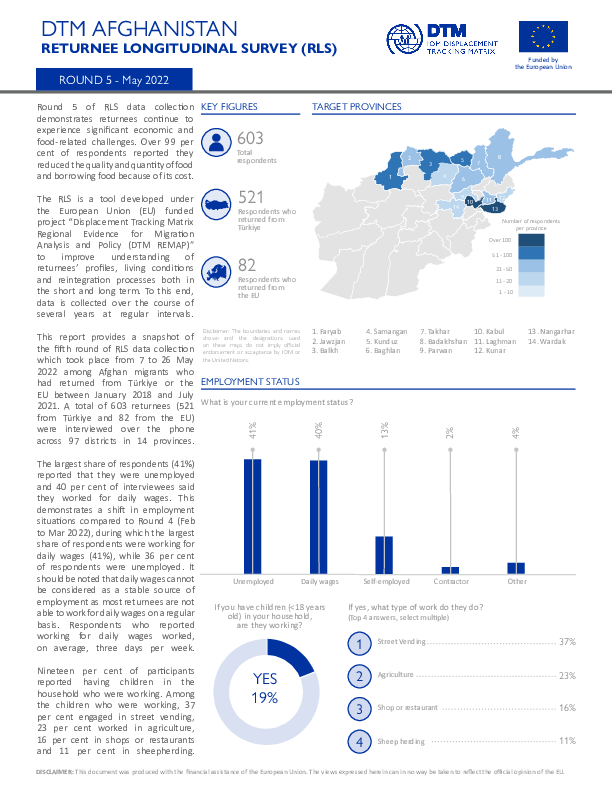
Contact
DTMAfghanistan@iom.int
Language
English
Location
Afghanistan
Period Covered
May 07 2022
May 26 2022
Activity
- Survey
To better understand the demographic profiles, living conditions and reintegration processes of Afghan returnees, IOM, under the EU-funded project “Displacement Tracking Matrix Regional Evidence for Migration Analysis and Policy (DTM REMAP)”, developed the Returnee Longitudinal Survey (RLS). This RLS Report provides a snapshot of the of RLS data collection which took place on 7 – 26 May 2022 among Afghan nationals who had returned from Türkiye or the EU between January 2018 and July 2021. A total of 603 returnees (521 from Türkiye and 82 from the EU) were interviewed over the phone across 97 districts in 14 provinces. RLS data collected in May 2022 demonstrates returnees continue to experience significant economic and food-related challenges in Afghanistan.
To better understand the demographic profiles, living conditions and reintegration processes of returnees, IOM, under the EU-funded project “Displacement Tracking Matrix Regional Evidence for Migration Analysis and Policy (DTM REMAP)”, developed the Returnee Longitudinal Survey (RLS). This report intends to provide summary findings of the first round of RLS data collection that took place in Afghanistan (May to August 2021), Bangladesh (October 2020 to January 2021), Iraq (August to September 2020) and Pakistan (January to April 2021). While the RLS also collects data on the sustainability of reintegration (economic, social and psychosocial), this summary report solely focuses on the analysis and comparison of data collected in the four countries on the profiles of the returnees. The specific thematic areas for analysis under this report include: socio-demographic background, employment status, income status, debt status, migration drivers, return journey and prior migration experience and re-migration intentions.
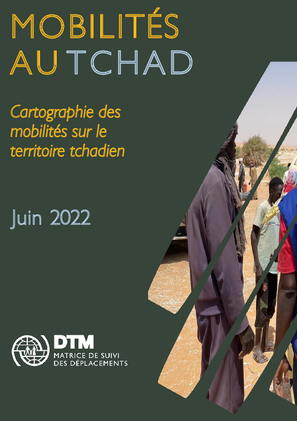
Contact
DTM Tchad, dtmtchad@iom.int
Language
French
Location
Chad
Snapshot Date
Jun 30 2022
Activity
- Other
- Survey
- Flow Monitoring Survey
- Return Intention
- Registration
- Rapid Emergency Registration
- Flow Monitoring
- Migrants presence
- Mobility Tracking
- Site Assessment
- Event Tracking
- Baseline Assessment
- Village Assessment
Ce rapport est composé d’un ensemble de cartes présentant les différents phénomènes et tendances migratoires au Tchad. Il décrit les différents mouvements de populations recensés depuis, vers et au sein du territoire tchadien et dresse le profil des populations en mouvement. Parmi les types de mobilités traitées dans ce document figurent les mouvements socioéconomiques; les mouvements de Tchadiens vers l’étranger et de ressortissants étrangers au Tchad; les transhumances ; les déplacements forcés et les retours facilités par l’OIM. Souvent, ces différentes mobilités se croisent et s’imbriquent. Ce rapport tente de mettre en lumière ce lien et de mieux saisir les dynamiques y afférentes. Ce rapport est le résultat d’une compilation de diverses bases de données, de rapports provenant de différentes sources d’information et de témoignages recueillis directement auprès des populations mobiles ou d’informateurs clés. Les sources sont indiquées dans chacune des pages. S’il ne peut pas être considéré comme complet ou représentatif, le rapport offre une image générale de la situation migratoire au Tchad.
Starting on 24 February 2022, the war in Ukraine triggered an unprecedented humanitarian crisis and generated large scale displacement both within Ukraine and to the neighbouring countries. As of the end of May, 7.1 million persons were internally displaced in Ukraine1 and almost 7 million crossings of refugees and other Third-Country-Nationals (TCNs) not in need of international protection from Ukraine into the neighbouring countries were reported.2 However, since April, an increasing number of returns have been identified both from other locations in Ukraine and self-reported returns from abroad and according to UNHCR about 2.1 million crossings were registered from neighbouring countries into Ukraine as of the end of May.
This report is based on 3,424 valid surveys collected by IOM’s Displacement Tracking Matrix (DTM) in four European countries neighbouring Ukraine with adult refugees from Ukraine and TCNs crossing to Ukraine between 16 April and 31 May 2022: 708 surveys in Poland, 2,102 in the Republic of Moldova, 514 in Romania and 100 in Slovakia. Total results were weighted with equal weights per each country sub-sample.
Individual crossings back into Ukraine are not necessarily returnees and conclusions on definitive trends cannot yet be drawn. The sample is not representative of all persons crossing to Ukraine and results should only be considered as indicative.

Contact
DTM Europe, DTMMediterranean@iom.int
Language
English
Location
Republic of Moldova
Period Covered
Apr 16 2022
May 27 2022
Activity
- Survey
- Return Intention
Since 24 February 2022, an increasing number of people fleeing from Ukraine to the neighbouring countries has been observed, as a result of the war in Ukraine. As of 7 June, 489,283 Ukrainian refugees and third country nationals (TCNs) were registered at border crossing points (BCPs) while entering from Ukraine into the Republic of Moldova. Additionally, 87,621 Ukrainian refugees and TCNs, who have entered into the Republic of Moldova after 24 February, have since exited back to Ukraine.
This report presents a summary of displacement survey findings commissioned by the International Organization for Migration (IOM) in partnership with UN Women. Data were collected before crossing to Ukraine at three main border crossing points (BCPs) – Palanca and Tudora (Stefan Voda district in the South) and Otaci (Ocnita district in the North) between 16 April and 27 May. Individual crossings into Ukraine are not necessarily returnees and conclusions on definitive trends cannot yet be drawn. The sample is not representative of all persons crossing to Ukraine, and results should only be considered as indicative.
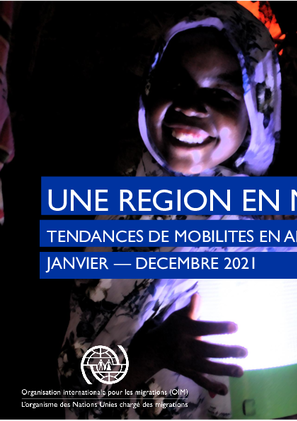
Contact
RO Dakar, RODakar-DataResearch@iom.int
Language
French
Activity
- Other
- Survey
- Community Perception
- Flow Monitoring Survey
- Return Intention
- Registration
- Flow Monitoring
- Migrants presence
- Mobility Tracking
- Site Assessment
- Event Tracking
- Baseline Assessment
- Points of Entry (PoE)
Le présent rapport vise à fournir un aperçu sur les tendances principales de mobilités de populations en Afrique de l’Ouest et du Centre en 2021. Il aborde la mobilité régionale selon deux grandes lignes : les déplacements internes et les flux migratoires. Dans chaque section, le rapport présente des tendances primaires de mobilités, les évènements clés, et les profils de populations mobiles observées en 2021. L’édition 2020 de ce rapport contient en outre des sections qui examinent en détail l’impact de la crise de COVID-19 sur la mobilité régionale, les migrations environnementales et climatiques et les solutions durables aux déplacements forcés dans la région.
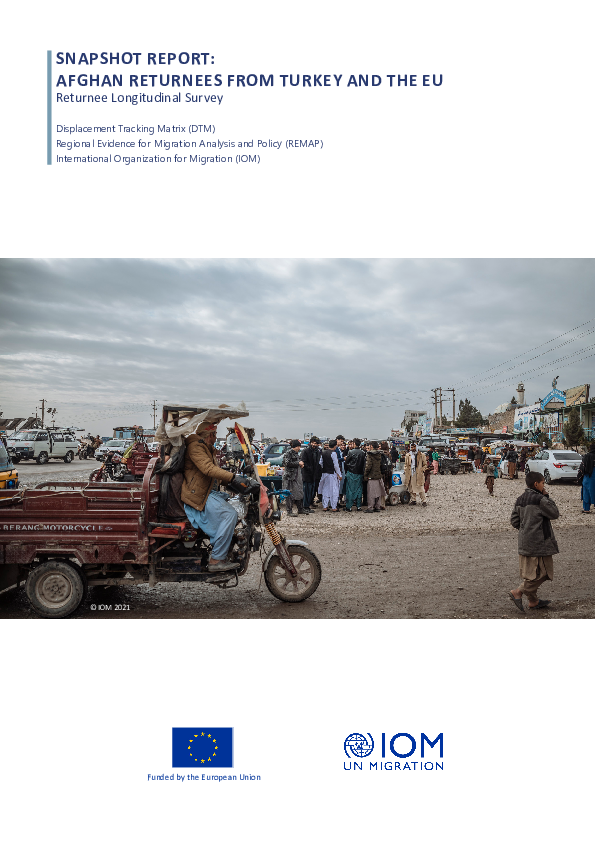
Contact
DTMAfghanistan@iom.int
Language
English
Location
Afghanistan
Period Covered
May 01 2021
Aug 31 2021
Activity
- Survey
- Return Intention
This report is the result of the first round of data collection that took place from May to August 2021 with Afghan migrants who returned from Turkey and the EU in 2018, 2019, 2020 and 2021 through IOM’s Assisted Voluntary Return and Reintegration (AVRR) and Stabilisation, Reintegration and Resilience (SRR) programmes. During the data collection period, 998 respondents were interviewed in person or over the phone across 102 districts in 17 provinces.
This report is divided into three main sections. The first section summarises the key findings in this report. The second section starts with a description of the methodology and includes the research method, sampling information and limitations. The third section presents the analysis of the data that was collected between May and August 2021. The analysis chapter is further subdivided into eight thematic sections. The first subsection covers the demographics and socio-economic profiles of the return migrants. This is followed by a subsection on the employment situation, occupational sector and income and debt status of the returnees (prior to migration; in Turkey or the EU and in Round 1, which took place from May to August 2021). The third subsection explores the reasons for migration. The fourth subsection examines the migration journey, including the reasons for migrating to Turkey or the EU. The following subsection dives deeper into the reasons for return and then an additional subsection goes into the challenges that returnees experience after returning to Afghanistan. Finally, the last two subsections examine prior migration experiences and re-migration intentions.
Pagination
- Previous page
- Page 12
- Next page


